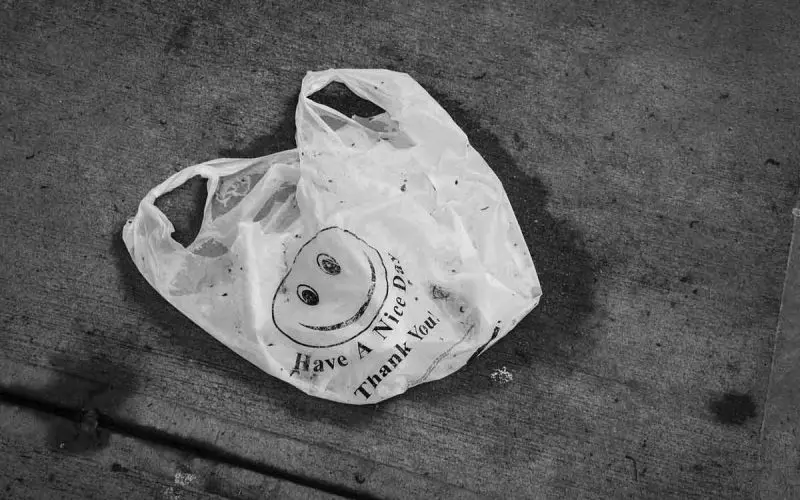Table of Contents Show
It is estimated that one trillion plastic bags are used and disposed around the world every year.
Most of these plastic bags are traditional ones, made with petroleum. We’ve been using those for quite some time.
Navigation:
Environmental Impact of Plastic Bags
Solutions to the plastic bag crisis
Environmental Impact of Plastic Bags
The United States annually uses 12 million barrels of oil to make plastic bags. During plastic bags manufacturing, tons of carbon and other toxic chemicals are released into the atmosphere.
Out of those one trillion plastic bags being used worldwide, only 5% are recycled. The remainder ends up in landfills.
Some get lost to the environment where they may go onto contaminate soil and waterways. Here, they endanger bird and marine life.
They also enter the food chain when animals ingest them mistaking them for food. Ingesting plastic is potentially harmful and results in serious health effects, for humans too.
Even plastic bags with minimum toxicity (being used by grocers) release a chemical that can seriously alter the structure and function of human cells.
Do plastic bags decompose?
Plastic bags made of petroleum do not undergo decomposition
Decomposition is defined as a natural/biological process where microorganisms feed on organic matter and transform it into humus, forming a rich soil.
Most of the plastic bags don’t undergo decomposition. This is because they are not made of organic matter but from petroleum byproducts that microorganisms can’t eat.
They are said to never go through decomposition at all.
However, if given the right conditions and a thousand years, these plastic bags may photodegrade. This isn’t the same as decomposition.
It means that the plastic will break down into smaller pieces. There is no reabsorption or transformation of natural elements like carbon and hydrogen which plastic bags are made of.
Right conditions to photodegrade (mainly light) are not available in landfills where majority of plastic bags end up. These plastic bags will never biodegrade or decompose.
As far as we know, current scientific data suggests they will remain as plastic bags or as plastic fragments forever.
The process of photodegradation
Once the sun’s UV rays strike the plastic, it makes the plastic brittle. This breaks up the molecular chains that hold it together. The plastic breaks up into smaller pieces. T
These plastic fragments then easily enter the food chain when animals mistakenly ingest them as food.
Minute piecies of plastic (or microplastics) will end up in the oceans. Marine organisms also mistaken them for food and eat them. Those micro-plastics end up in our bodies when we eat fish.
Research estimates that a single human consumes between 40,000 to 50,000 pieces of plastic every year, through food and drink. We inhale even more micro-plastics (74,000) annually!
Solutions to the plastic bag crisis
Over the recent years, an alternative “compostable” or bioplastic bag has been made from biodegradable materials like soy protein, cellulose, starch, or lactic acid.
Here are some Eco-friendly plastic bag alternatives. It sounds like a perfect Eco-solution, or is it?
Making biodegradable bags requires crops to be grown for exclusive purpose of making them.
Higher demand for crop production requires new cropland. This will promote deforestation of trees. These forest trees would otherwise absorb carbon.
Plants also produce the oxygen we breathe!
Agriculture (through deforestation at an industrial level) is one of the largest environmental issues that we face today.
These issues are promoting climate change and global warming; along with contamination of air, and even water supply due to fertilizers and pesticides.
Furthermore, the decomposition process for plastic bags is not feasible. It requires specific conditions of high temperature for long periods at a composting facility.
This is unfortunately very tedious and expensive for facilities that technically don’t have this capacity.
P.S: Even landfills don’t have such conditions.
Many municipal facilities have started collecting compostable bags. Those that end up in landfills then start to emit large amounts of methane in the natural composting process.
A further concern is based on the fact that many companies have gone on to market their plastic as safe for the environment, which is not the case.
What about paper bags?
Sadly, paper bags aren’t a good alternative either.
Paper bags will definitely biodegrade in a pile of compost completely. However, it can’t compost in a landfill. This is due to lack of microorganism to break it down. Other important factors needed for biodegradation like water, light, and oxygen are also not available.
Paper bag production requires four times the energy in manufacturing a plastic bag. Additionally, it also generates 70% more air pollutants and 50 times water pollutants compared to plastic bags.
If we do choose to however start using paper bags more commonly, we must recycle all of them.
What are tote bags?
A tote bag is a large bag, shaped just like a plastic bag, with handles coming from two of its sides.
Here’s an example of a tote bag on Amazon. I’ve been using this one to get groceries for two years now; and would recommend it for your use too.
Tote bags are usually made of cloth and often used as reusable shopping bags. Recently, factories have started making tote bags out of recycled organic materials like Nylon.
This is regarded as the best solution currently and is being embraced by consumers and governments throughout the world.
Totes are commonly being used in Europe and are being encouraged by grocers in the United States.
Kroger, one of the largest retail grocers in the USA has signs in parking lots that say: “did you remember your reusable bag?”
However, the use of totes has also been attacked by a study showing that manufacturers and the life span of totes has a greater carbon footprint than plastic bags.
This report measures the global warming impact and concluded that a cotton bag would have to be used about 131 times to match the carbon footprint of using a single-use plastic bag once.
This number isn’t that high as it seems.
This is especially true when you consider the fact that many people buy grocery every other day and that these totes can be used for several years.
However, the same report said that the cotton bag is not as hygienic as it can be a breeding nest for various harmful microorganisms due to its organic nature.
The solution is very straightforward. Keep the bag clean and dry, and it can be used for years.
Cotton can be seen as the least-taxing tote material on the environment as it is made of organic materials which can decompose at the end of its life.
The re-using of totes has now become a practice that is encouraged by many governments around the world.
They’ve achieved this through various ways which include outright banning of plastic bags, imposing taxes on use and raising awareness.
P.S: Tote bags made of recycled plastic need to be reused 11 times to match their environmental footprint.
If you are in a situation where you can only use disposable plastic bags, you must recycle them.
Many businesses now reclaim used plastics. In the US, many stores that offer plastic bags also have recycling bins to return them after use.






